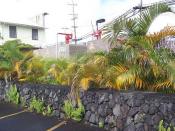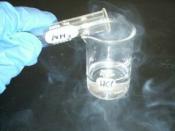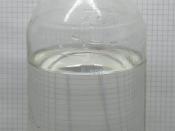Rate of reaction
The Effect of concentration on the reaction between magnesium and hydrochloric acid.
Mg(s) + 2HCl(aq) MgCl2(aq) + H2(g)
Aim:
In this experiment I am going observe and record the reaction between magnesium and different concentrations of hydrochloric acid.
Prediction:
I think that the high concentrations of acid such as 1.0 and 0.8mols we have the most rapid reaction and let off more gas a lot quicker. The weaker concentrations such as 0.2 will let off a smaller amount of CO2 because there is not much acid for the magnesium to react with.
Equipment:
Eye protection
Hydrochloric acid (1mol/dm3)
Magnesium ribbon
Distilled water
Conical flask
Delivery tube
Water trough
Measuring Cylinders to collect gas, 100cm3
Stopwatch
Method:
1. Firstly I will get the required concentrations made up using a measuring cylinder to make sure the concentrations are right.
2. I will then weigh up 0.1g of magnesium ribbon.
3. I will then add the magnesium to the first concentration and use a stop watch to record the amount of gas for 3 minutes taking 20 second intervals.
4. I will do this for all the concentrations.
5. Once all the results for the concentrations have been recorded I will be finished.
How to make up the concentrations:
Concentration of acid Volume of concentration cm3 Hydrochloric acid Distilled Water
1.0 20cm3 20cm3 0cm3
0.8 20cm3 16cm3 4cm3
0.6 20cm3 12cm3 8cm3
0.4 20cm3 8cm3 12cm3
0.2 20cm3 4cm3 16cm3
Results:
Volume of gas at time (cm3)
Concentration of acid 0
20 40 60 80 100 120 140 160 180
1.0cm3 0 25 44 62 74 81 89 92 94 96
0.8cm3 0 7 15 21 27 34 40 46 51 55
0.6cm3 0 4 10 17 25 32 39 46 50 54
0.4cm3 0 2 4 7 10 12 15 17...


